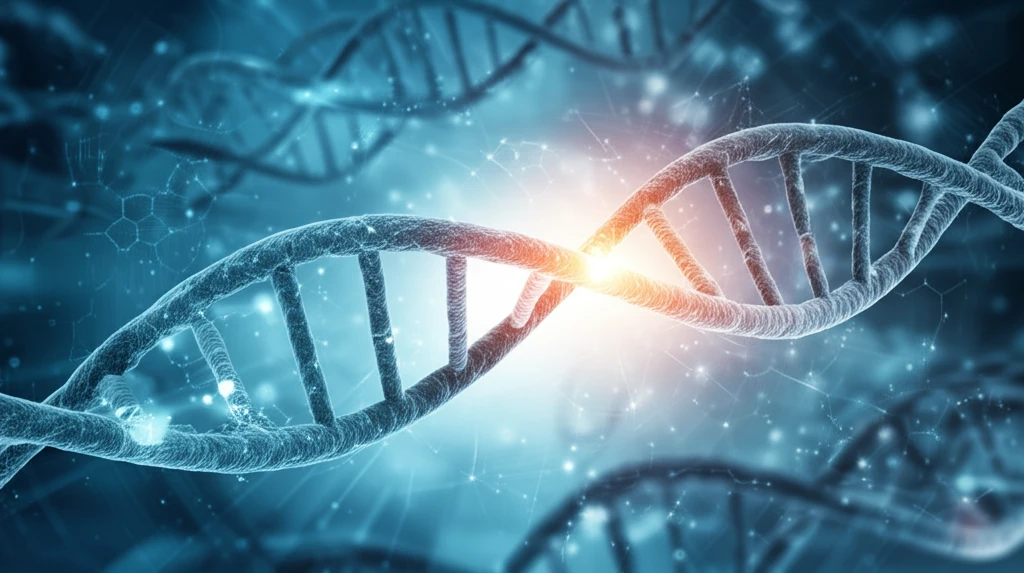
Decoding DNA Repair: Can We Turn Off 'Bad' Genes to Prevent Disease?
"Unlocking the Secrets of Synthetic Lethality and the Trp53 Gene in DNA Repair Mechanisms"
Our bodies are constantly under attack at the cellular level. From environmental toxins to the natural wear and tear of replication, our DNA faces a barrage of threats daily. Fortunately, we have sophisticated repair mechanisms in place to correct these damages, ensuring our cells function correctly and prevent mutations that could lead to disease. However, sometimes these repair systems falter, leading to genomic instability and potential catastrophe.
One of the key processes in maintaining genomic integrity is Non-Homologous End Joining (NHEJ). This pathway is crucial for repairing double-strand breaks (DSBs) in DNA, which can occur spontaneously or due to external factors. During NHEJ, various proteins and enzymes work together to sense, process, and ligate the broken DNA strands, restoring the integrity of the genome. Key players in this process include the Ku70 and Ku80 subunits, which bind to DSBs and recruit other essential factors like PAXX, Mri, DNA-PKcs, Artemis, XRCC4, and DNA ligase 4.
Recent research has focused on understanding the interactions between these DNA repair factors and how their combined inactivation can lead to synthetic lethality—a condition where the simultaneous loss of function of two or more genes results in cell death, whereas the loss of only one of these genes does not. A particularly interesting area of study involves the tumor protein p53, encoded by the Trp53 gene, a critical regulator of the cell cycle, DNA repair, and apoptosis. New studies reveal that inactivating Trp53 can rescue the synthetic lethality caused by the combined dysfunction of other DNA repair genes, offering new insights into potential therapeutic interventions.
How Does Trp53 Inactivation Rescue DNA Repair?

Scientists have discovered that the combined inactivation of certain DNA repair factors, such as Xlf and Dna-pkcs, or Xlf and Paxx, leads to synthetic lethality in mice. This means that when both gene pairs are non-functional, cells die, leading to severe developmental or health issues. Interestingly, this lethality is often associated with increased apoptosis, or programmed cell death, particularly in the central nervous system.
- Rescuing Embryonic Lethality: Inactivating one or both alleles of Trp53 allowed mice with deficiencies in both Xlf and Paxx to survive, indicating that Trp53 is a critical factor in the lethality observed when these DNA repair genes are absent.
- Immunodeficiency Phenotype: While the inactivation of Trp53 rescued the mice from embryonic lethality, the resulting mice exhibited immunodeficiency. This highlights a trade-off where preventing cell death allows survival but compromises the immune system.
- Combined Inactivation of Paxx and Dna-pkcs: Further experiments showed that combined inactivation of Paxx and Dna-pkcs resulted in viable and fertile mice, indistinguishable from Dna-pkcs knockout controls. This suggests that there is no significant functional redundancy between PAXX and DNA-PKcs in mouse development, challenging previous assumptions.
Future Directions and Therapeutic Implications
This research opens new avenues for therapeutic interventions targeting DNA repair mechanisms. By understanding the genetic interactions and synthetic lethalities involved, scientists can develop strategies to selectively kill cancer cells with specific DNA repair deficiencies. For example, if cancer cells have a defect in one DNA repair pathway, inhibiting another related pathway could induce synthetic lethality, leading to targeted cell death while sparing healthy cells. Furthermore, modulating the activity of Trp53 could enhance the effectiveness of these therapies, providing a more personalized and effective approach to cancer treatment.
